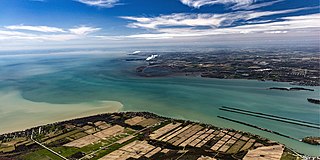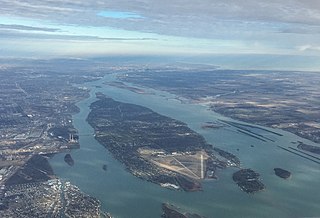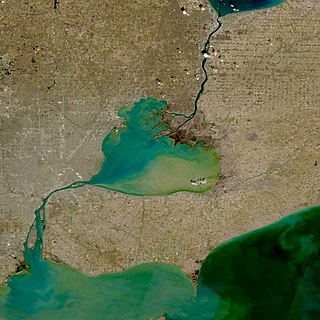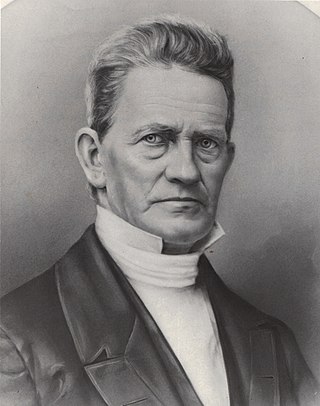
The Detroit River flows west and south for 24 nautical miles from Lake St. Clair to Lake Erie as a strait in the Great Lakes system. The river divides the metropolitan areas of Detroit, Michigan, and Windsor, Ontario—an area collectively referred to as Detroit–Windsor—and forms part of the border between Canada and the United States. The Ambassador Bridge, the Detroit–Windsor Tunnel, and the Michigan Central Railway Tunnel connect the cities.

Drummond Township, which comprises Drummond Island, is a civil township of Chippewa County in the U.S. state of Michigan. The population was 973 at the 2020 census.

Sault Ste. Marie is a city in the Upper Peninsula of the U.S. state of Michigan. It is the county seat of Chippewa County and is the only city within the county. With a population of 13,337 at the 2020 census, it is the second-most populated city in the Upper Peninsula, behind Marquette. It is the primary city of the Sault Ste. Marie, MI Micropolitan Statistical Area, which encompasses all of Chippewa County and had a population of 36,785 at the 2020 census. Sault Ste. Marie was settled by mostly French colonists in 1668, making it the oldest city in Michigan.

Grosse Ile Township is a civil township of Wayne County in the U.S. state of Michigan. The population was 10,777 at the 2020 census.

The St. Marys River, sometimes written St. Mary's River, drains Lake Superior, starting at the end of Whitefish Bay and flowing 74.5 miles (119.9 km) southeast into Lake Huron, with a fall of 23 feet (7.0 m). For its entire length it is an international border, separating Michigan in the United States from Ontario, Canada.

The St. Clair River is a 40.5-mile-long (65.2 km) river in central North America which flows from Lake Huron into Lake St. Clair, forming part of the international boundary between Canada and the United States and between the Canadian province of Ontario and the U.S. state of Michigan. The river is a significant component in the Great Lakes Waterway, whose shipping channels permit cargo vessels to travel between the upper and lower Great Lakes.
St. Joseph Island is in the northwestern part of Lake Huron. It is part of the Canadian province of Ontario. At 365 km2 (141 sq mi) in area, it is the sixth largest lake island in the world; the second largest island on Lake Huron, following Manitoulin Island; and the third largest of all the islands on the Great Lakes, trailing Manitoulin and Lake Superior's Isle Royale.
Sugar Island is an island in the U.S. state of Michigan in the St. Marys River between the United States and the Canadian province of Ontario. The entire island constitutes Sugar Island Township in Chippewa County at the eastern tip of the Upper Peninsula. According to the 2000 census there were 683 people living on a land area of 128 square kilometers ; about 14 people per square mile.

Harsens Island is a wet marshy location at the mouth of the St. Clair River on Lake St. Clair, in the U.S. state of Michigan. Politically, the island is in Clay Township of St. Clair County.

U.S. Highway 90 (US 90), one of the major east–west U.S. Highways in the Southern United States, runs through southern Louisiana for 297.6 miles (478.9 km), serving Lake Charles, Lafayette, New Iberia, Morgan City, and New Orleans. Much of it west of Lafayette and east of New Orleans has been supplanted by Interstate 10 (I-10) for all but local traffic, but the section between Lafayette and New Orleans runs a good deal south of I-10.

The Charlotte River is a tributary of the St. Marys River in the state of Michigan in the United States. The stream is 17.1 miles (27.5 km) long and drains an area of 58.4 square miles (151 km2) on the eastern Upper Peninsula. Via the St. Marys River, it is part of the watershed of Lake Huron. Via Lake Huron and the Great Lakes system, it is part of the larger watershed of the St. Lawrence River.

MV Paul R. Tregurtha is a Great Lakes-based bulk carrier freighter. She is the current Queen of the Lakes, an unofficial but widely recognized title given to the longest vessel active on the Great Lakes. Launched as MV William J. De Lancey, she was the last of the thirteen "thousand footers" to enter service on the Great Lakes, and was also the last Great Lakes vessel built at the American Ship Building Company yard in Lorain, Ohio. The MV Paul R. Tregurtha is the current flagship for the Interlake Steamship Company.

William Montague Ferry Sr. was a Presbyterian minister, missionary, and community leader who founded several settlements in Ottawa County, Michigan. He became known as the father of Grand Haven and father of Ottawa County.

Due to its unique geography, being made of two peninsulas surrounded by the Great Lakes, Michigan has depended on many ferries for connections to transport people, vehicles and trade. The most famous modern ferries are those which carry people and goods across the Straits of Mackinac to the car-free Mackinac Island but before the Mackinac Bridge was built, large numbers of ferries carried people and cars between the two peninsulas. Other ferries continue to provide transportation to small islands and across the Detroit River to Canada. Ferries once provided transport to island parks for city dwellers. The state's only national park, Isle Royale cannot be reached by road and is normally accessed by ferry. The largest ferries in Michigan are the car ferries which cross Lake Michigan to Wisconsin. One of these, the SS Badger is one of the last remaining coal steamers on the Great Lakes and serves as a section of US Highway 10 (US 10). The Badger is also the largest ferry in Michigan, capable of carrying 600 passengers and 180 autos.

The St. Joseph Channel is a strait in Algoma District, Northwestern Ontario, Canada and Chippewa County, Michigan, United States. It is in the Great Lakes Basin and connects the St. Marys River flowing through the Middle Neebish Channel between Neebish Island and Sugar Island at the northwest and Lake George/ East Neebish Channel between Sugar Island and the Ontario mainland at the north, with the North Channel between St. Joseph Island and the Ontario mainland at the east, and with the Munuscong Channel between Neebish Island and St. Joseph Island at the southwest. All of these waterbody elements are part of Lake Huron.
Lake George is a lake in Chippewa County, Michigan, United States, and Algoma District, Northwestern Ontario, Canada, that lies between Sugar Island in Michigan on the west and the Ontario mainland on the east.

Stony Island is an island in the Detroit River, in southeast Michigan. It has been used for hunting and fishing as long as humans have inhabited the region; from the mid-19th century to the mid-20th century, it was the site of a small settlement and served as a central location for the construction of the Livingstone Channel, as well as various civil engineering projects involving the Detroit River. By the 1990s, it had become completely uninhabited; it is now open to the public and administered by the Michigan Department of Natural Resources.
Munuscong Lake is a section of the St. Marys River in Chippewa County in the U.S. state of Michigan, with the northeastern edge of the lake forming part of the riparian bottomland of the Canadian province of Ontario. Hydrologically the lake and river section are an arm of Lake Huron, and Munuscong Lake shares a common water level with the Great Lake into which it flows.

















